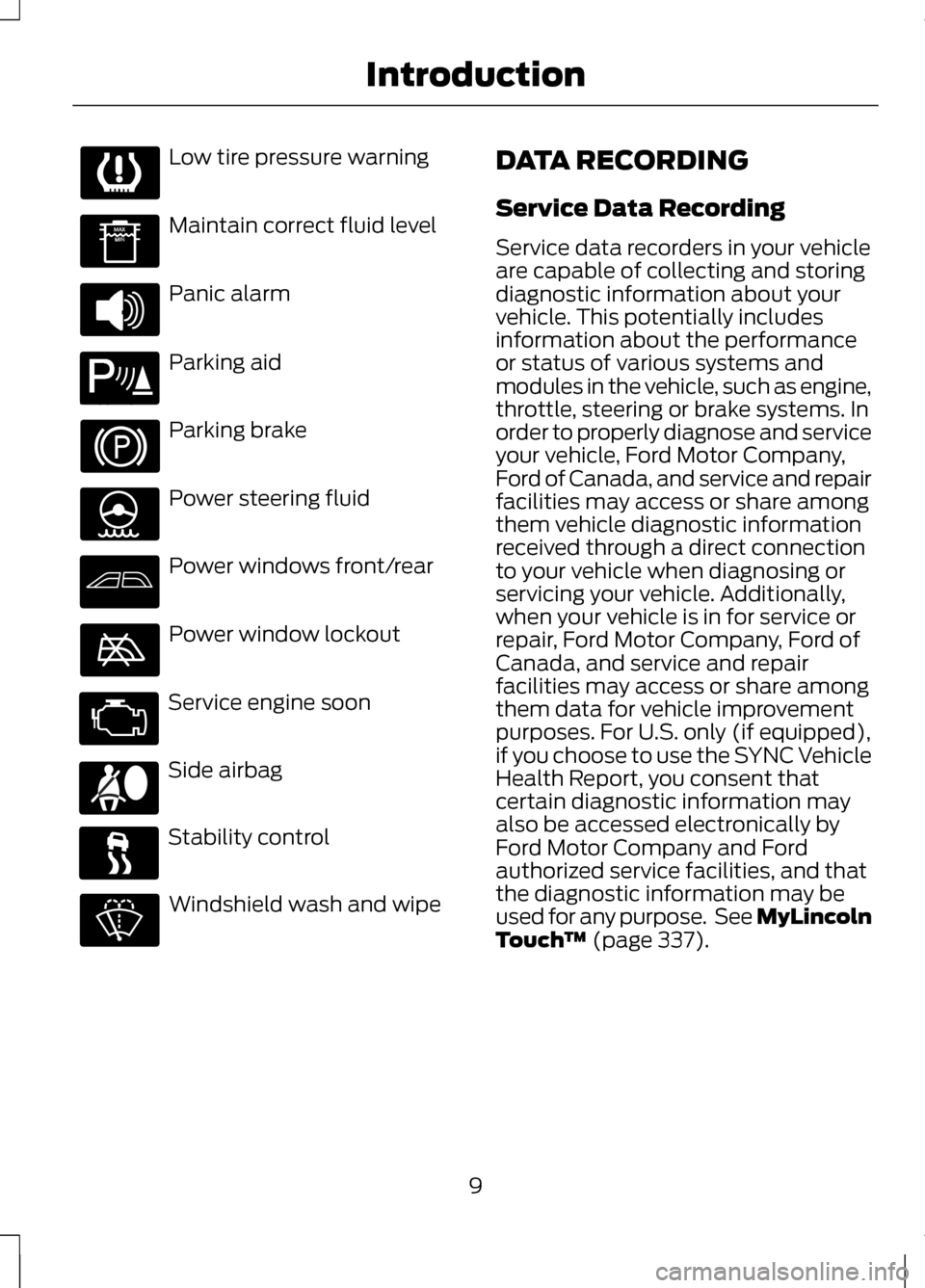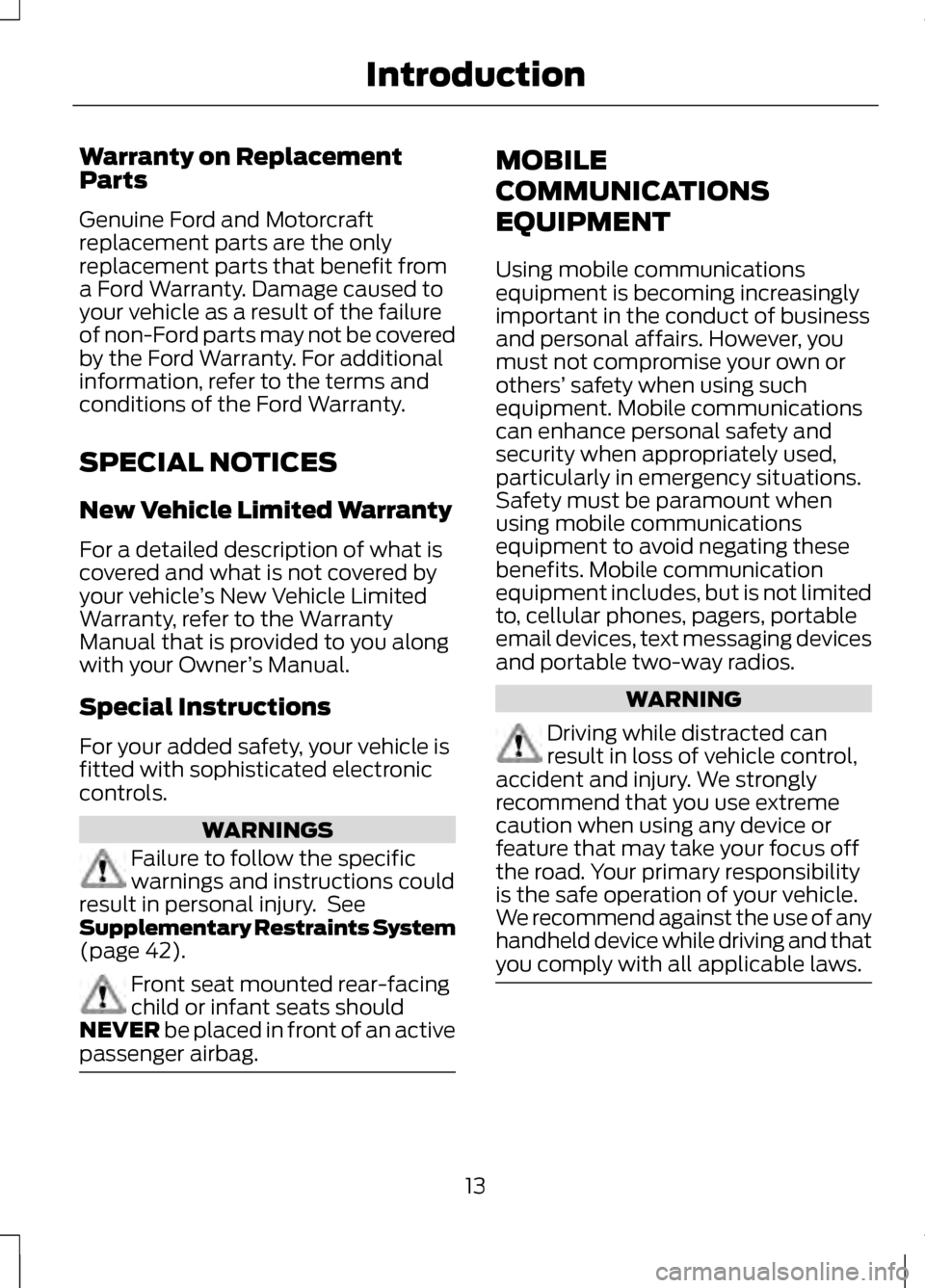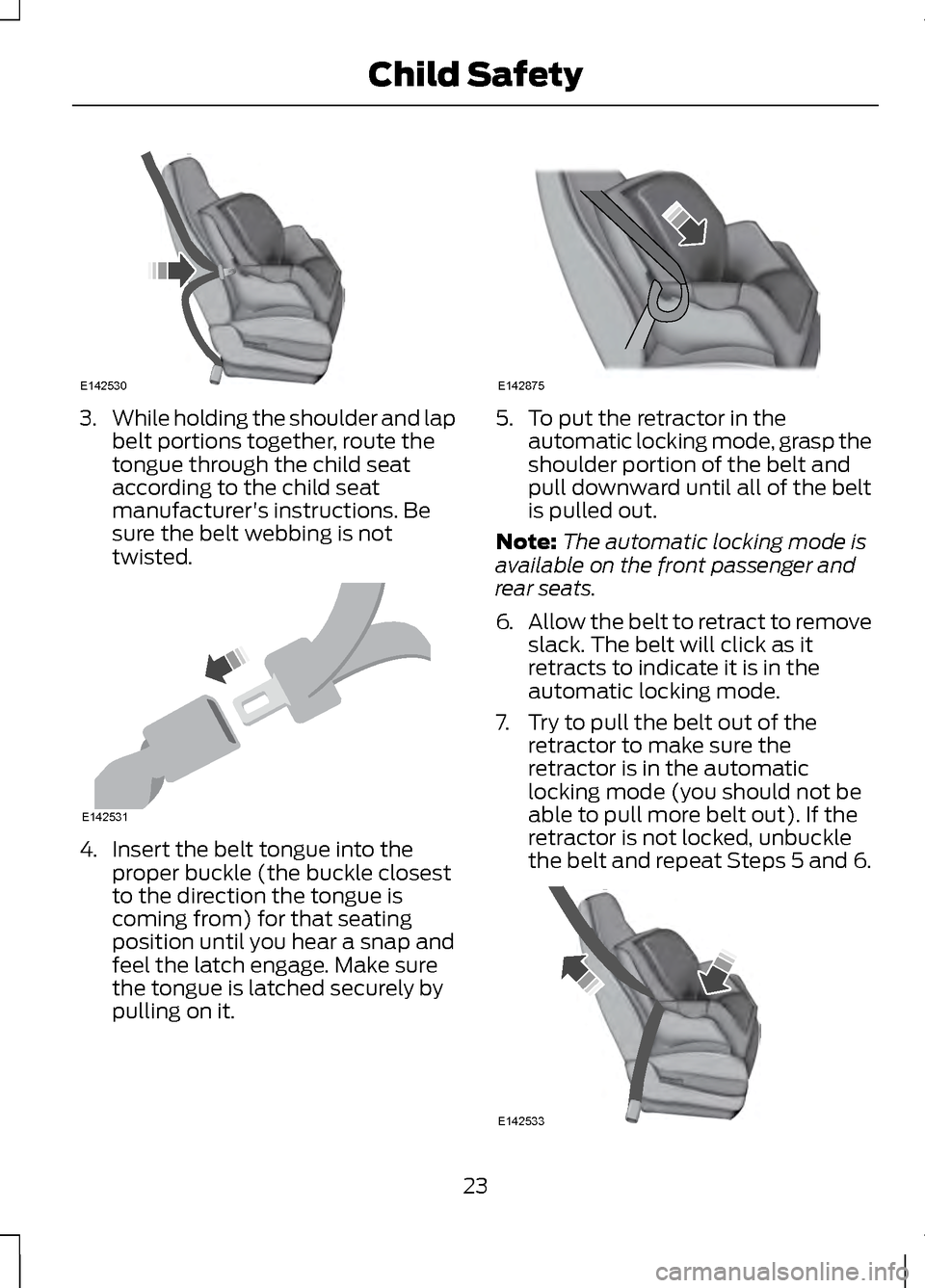Rear LINCOLN MKZ 2013 Owners Manual
[x] Cancel search | Manufacturer: LINCOLN, Model Year: 2013, Model line: MKZ, Model: LINCOLN MKZ 2013Pages: 474, PDF Size: 3.79 MB
Page 5 of 474

Security
Passive Anti-Theft System................72
Anti-Theft Alarm
...................................73
Steering Wheel
Adjusting the Steering Wheel...........75
Audio Control
.........................................76
Voice Control
...........................................77
Cruise Control
.........................................77
Information Display Control..............77
Heated Steering Wheel......................78
Wipers and Washers
Windshield Wipers
...............................79
Autowipers..............................................79
Windshield Washers
...........................80
Lighting
Lighting Control
.....................................82
Autolamps...............................................82
Instrument Lighting Dimmer............83
Headlamp Exit Delay...........................83
Daytime Running Lamps...................83
Automatic High Beam Control
........84
Direction Indicators
..............................85
Interior Lamps
........................................85
Windows and Mirrors
Power Windows
....................................87
Global Opening and Closing............88
Exterior Mirrors......................................88
Interior Mirror
.........................................90
Sun Visors
...............................................90
Sun Shades
..............................................91 Moonroof..................................................91
Instrument Cluster
Gauges......................................................94
Warning Lamps and Indicators.......95
Audible Warnings and
Indicators.............................................99
Information Displays
General Information
..........................100
Information Messages
......................105
Audio System
General Information
...........................122
Audio unit - Vehicles With: Premium AM/FM/CD
........................................123
Media Hub
..............................................125
Climate Control
Automatic Climate Control.............126
Hints on Controlling the Interior Climate................................................127
Heated Windows and Mirrors.........128
Cabin Air Filter
......................................129
Remote Start
........................................129
Seats
Sitting in the Correct Position
..........131
Head Restraints
....................................131
Power Seats
..........................................133
Memory Function................................135
Rear Seats..............................................137
Heated Seats
.........................................137
Ventilated Seats
..................................139
Rear Seat Armrest
..............................140
2
Table of Contents
Page 6 of 474

Universal Garage Door
Opener
Universal Garage Door Opener......142
Auxiliary Power Points
Auxiliary Power Points.......................147
Storage Compartments
Center Console....................................149
Overhead Console..............................149
Starting and Stopping the Engine
General Information
..........................150
Keyless Starting...................................150
Starting a Gasoline Engine..............152
Engine Block Heater
...........................153
Fuel and Refueling
Safety Precautions
.............................155
Fuel Quality
...........................................156
Running Out of Fuel...........................156
Refueling................................................158
Fuel Consumption
..............................160
Emission Control System..................161
Transmission
Automatic Transmission
..................165
Hill Start Assist
.....................................170
All-Wheel Drive
Using All-Wheel Drive.........................171
Brakes
General Information............................177 Hints on Driving With Anti-Lock
Brakes..................................................178
Electric Parking Brake
........................178
Traction Control
Principle of Operation
........................181
Using Traction Control.......................181
Stability Control
Principle of Operation.......................182
Using Stability Control......................183
Parking Aids
Parking Aid
............................................184
Active Park Assist...............................186
Rear View Camera...............................191
Cruise Control
Principle of Operation.......................195
Using Cruise Control..........................195
Using Adaptive Cruise Control
.......196
Driving Aids
Driver Alert............................................203
Lane Keeping System......................208
Blind Spot Monitor..............................212
Steering...................................................217
Load Carrying
Load Limit..............................................219
Towing
Towing a Trailer
....................................227
Recommended Towing Weights...............................................227
3
Table of Contents
Page 11 of 474

Battery
Battery acid
Brake fluid - non petroleum
based
Brake system
Cabin air filter
Check fuel cap
Child safety door lock or
unlock
Child seat lower anchor
Child seat tether anchor
Cruise control
Do not open when hot
Engine air filter
Engine coolant
Engine coolant temperature Engine oil
Explosive gas
Fan warning
Fasten safety belt
Front airbag
Front fog lamps
Fuel pump reset
Fuse compartment
Hazard warning flashers
Heated rear window
Heated windshield
Interior luggage
compartment release
Jack
Lighting control
8
Introduction E71340 E91392
Page 12 of 474

Low tire pressure warning
Maintain correct fluid level
Panic alarm
Parking aid
Parking brake
Power steering fluid
Power windows front/rear
Power window lockout
Service engine soon
Side airbag
Stability control
Windshield wash and wipe DATA RECORDING
Service Data Recording
Service data recorders in your vehicle
are capable of collecting and storing
diagnostic information about your
vehicle. This potentially includes
information about the performance
or status of various systems and
modules in the vehicle, such as engine,
throttle, steering or brake systems. In
order to properly diagnose and service
your vehicle, Ford Motor Company,
Ford of Canada, and service and repair
facilities may access or share among
them vehicle diagnostic information
received through a direct connection
to your vehicle when diagnosing or
servicing your vehicle. Additionally,
when your vehicle is in for service or
repair, Ford Motor Company, Ford of
Canada, and service and repair
facilities may access or share among
them data for vehicle improvement
purposes. For U.S. only (if equipped),
if you choose to use the SYNC Vehicle
Health Report, you consent that
certain diagnostic information may
also be accessed electronically by
Ford Motor Company and Ford
authorized service facilities, and that
the diagnostic information may be
used for any purpose. See MyLincoln
Touch
™ (page 337).
9
Introduction E139213
Page 16 of 474

Warranty on Replacement
Parts
Genuine Ford and Motorcraft
replacement parts are the only
replacement parts that benefit from
a Ford Warranty. Damage caused to
your vehicle as a result of the failure
of non-Ford parts may not be covered
by the Ford Warranty. For additional
information, refer to the terms and
conditions of the Ford Warranty.
SPECIAL NOTICES
New Vehicle Limited Warranty
For a detailed description of what is
covered and what is not covered by
your vehicle
’s New Vehicle Limited
Warranty, refer to the Warranty
Manual that is provided to you along
with your Owner ’s Manual.
Special Instructions
For your added safety, your vehicle is
fitted with sophisticated electronic
controls. WARNINGS
Failure to follow the specific
warnings and instructions could
result in personal injury. See
Supplementary Restraints System
(page 42). Front seat mounted rear-facing
child or infant seats should
NEVER
be placed in front of an active
passenger airbag. MOBILE
COMMUNICATIONS
EQUIPMENT
Using mobile communications
equipment is becoming increasingly
important in the conduct of business
and personal affairs. However, you
must not compromise your own or
others’
safety when using such
equipment. Mobile communications
can enhance personal safety and
security when appropriately used,
particularly in emergency situations.
Safety must be paramount when
using mobile communications
equipment to avoid negating these
benefits. Mobile communication
equipment includes, but is not limited
to, cellular phones, pagers, portable
email devices, text messaging devices
and portable two-way radios. WARNING
Driving while distracted can
result in loss of vehicle control,
accident and injury. We strongly
recommend that you use extreme
caution when using any device or
feature that may take your focus off
the road. Your primary responsibility
is the safe operation of your vehicle.
We recommend against the use of any
handheld device while driving and that
you comply with all applicable laws. 13
Introduction
Page 20 of 474

•
You are required by law to properly
use safety seats for infants and
toddlers in the United States and
Canada.
• Many states and provinces require
that small children use approved
booster seats until they reach age
eight, a height of 4 feet 9 inches
(1.45 meters) tall, or 80 pounds
(36 kilograms). Check your local
and state or provincial laws for
specific requirements about the
safety of children in your vehicle.
• When possible, always properly
restrain children twelve years of
age and under in a rear seating
position of your vehicle. Accident
statistics suggest that children are
safer when properly restrained in
the rear seating positions than in
a front seating position. See Front
Passenger Sensing System
(page 45).
CHILD SEAT POSITIONING WARNINGS
Airbags can kill or injure a child
in a child seat. NEVER place a
rear-facing child seat in front of an
active airbag. If you must use a
forward-facing child seat in the front
seat, move your vehicle seat all the
way back. When possible, all children
age 12 and under should be properly
restrained in a rear seating position. If
all children cannot be seated and
restrained properly in a rear seating
position, properly restrain the largest
child in the front seat. WARNINGS
Always carefully follow the
instructions and warnings
provided by the manufacturer of any
child restraint to determine if the
restraint device is appropriate for your
child's size, height, weight, or age.
Follow the child restraint
manufacturer's instructions and
warnings provided for installation and
use in conjunction with the
instructions and warnings provided by
your vehicle manufacturer. A safety
seat that is improperly installed or
utilized, is inappropriate for your
child's height, age, or weight or does
not properly fit the child may increase
the risk of serious injury or death. Never let a passenger hold a
child on his or her lap while your
vehicle is moving. The passenger
cannot protect the child from injury in
a collision, which may result in serious
injury or death. Never use pillows, books, or
towels to boost a child. They can
slide around and increase the
likelihood of injury or death in a
collision. Always restrain an unoccupied
child seat or booster seat. These
objects may become projectiles in a
collision or sudden stop, which may
increase the risk of serious injury.
17
Child Safety
Page 21 of 474

WARNINGS
Never place, or allow a child to
place, the shoulder belt under a
child's arm or behind the back
because it reduces the protection for
the upper part of the body and may WARNINGS
increase the risk of injury or death in a
collision. Do not leave children or pets
unattended in your vehicle.
Use any attachment method as indicated below by X
Child
Weight
Restraint
Type Safety
belt only
Safety
belt and LATCH(lower
anchors and top tether
anchor)
Safety
belt and
top tether anchor
LATCH
(lower
anchors only)
LATCH
(lower
anchors and top tether
anchor)
X
X
Up to 48
lb (21 kg)
Rear
facing
child seat
X
X
X
Up to 48
lb (21 kg)
Forward
facing
child seat
X
X
Over 48
lb (21 kg)
Forward
facing
child seat
Note: The child seat must rest tightly
against your vehicle seat. It may be
necessary to lift or remove the head
restraint. See Seats (page 131). BOOSTER SEATS WARNING
Never place, or allow a child to
place, the shoulder belt under a
child's arm or behind the back
because it reduces the protection for
the upper part of the body and may
increase the risk of injury or death in a
collision. 18
Child Safety
Page 24 of 474

If the booster seat slides on your
vehicle seat, placing a rubberized
mesh sold as shelf or carpet liner
under the booster seat may improve
this condition. Do not introduce any
item thicker than this under the
booster seat. Check with the booster
seat manufacturer's instructions.
INSTALLING CHILD SEATS
Child Seats
Use a child safety seat (sometimes
called an infant carrier, convertible
seat, or toddler seat) for infants,
toddlers, or children weighing 40
pounds (18 kilograms) or less
(generally age four or younger). Using Lap and Shoulder Belts WARNINGS
Airbags can kill or injure a child
in a child seat. NEVER place a
rear-facing child seat in front of an
active airbag. If you must use a
forward-facing child seat in the front
seat, move the seat all the way back. Children 12 and under should be
properly restrained in the rear
seat whenever possible. Depending on where you secure
a child restraint, and depending
on the child restraint design, you may
block access to certain safety belt
buckle assemblies and LATCH lower
anchors, rendering those features
potentially unusable. To avoid risk of
injury, occupants should only use
seating positions where they are able
to be properly restrained. 21
Child SafetyE142597 E142594
Page 25 of 474

When installing a child safety seat
with combination lap and shoulder
belts:
•
Use the correct safety belt buckle
for that seating position.
• Insert the belt tongue into the
proper buckle until you hear a snap
and feel it latch. Make sure the
tongue is securely fastened in the
buckle.
• Keep the buckle release button
pointing up and away from the
safety seat, with the tongue
between the child seat and the
release button, to prevent
accidental unbuckling.
• Place your vehicle seat back in the
upright position.
• Put the safety belt in the
automatic locking mode. See Step
5. This vehicle does not require the
use of a locking clip.
Perform the following steps when
installing the child seat with
combination lap and shoulder belts:
Note: Although the child seat
illustrated is a forward facing child
seat, the steps are the same for
installing a rear facing child seat. Standard safety belts 1. Position the child safety seat in a
seat with a combination lap and
shoulder belt. 2. After positioning the child safety
seat in the proper seating position,
pull down on the shoulder belt and
then grasp the shoulder belt and
lap belt together behind the belt
tongue.
22
Child SafetyE142528 E142529
Page 26 of 474

3.
While holding the shoulder and lap
belt portions together, route the
tongue through the child seat
according to the child seat
manufacturer's instructions. Be
sure the belt webbing is not
twisted. 4. Insert the belt tongue into the
proper buckle (the buckle closest
to the direction the tongue is
coming from) for that seating
position until you hear a snap and
feel the latch engage. Make sure
the tongue is latched securely by
pulling on it. 5. To put the retractor in the
automatic locking mode, grasp the
shoulder portion of the belt and
pull downward until all of the belt
is pulled out.
Note: The automatic locking mode is
available on the front passenger and
rear seats.
6. Allow the belt to retract to remove
slack. The belt will click as it
retracts to indicate it is in the
automatic locking mode.
7. Try to pull the belt out of the retractor to make sure the
retractor is in the automatic
locking mode (you should not be
able to pull more belt out). If the
retractor is not locked, unbuckle
the belt and repeat Steps 5 and 6. 23
Child SafetyE142530 E142531 E142875 E142533